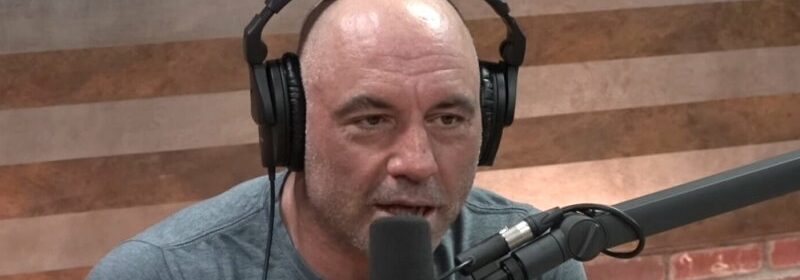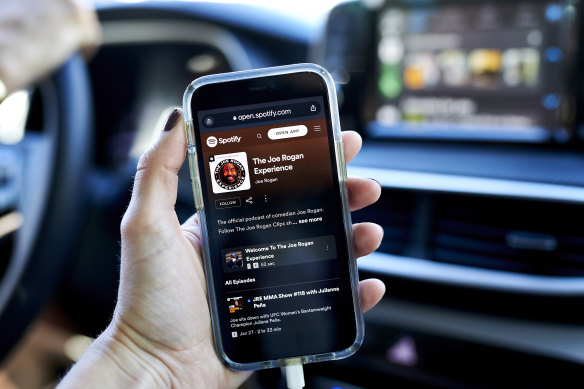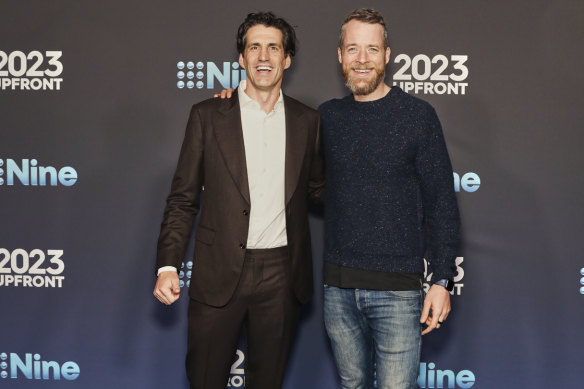Is the podcast bubble starting to burst?

Save articles for later
Add articles to your saved list and come back to them any time.
Podcasting is coming down from a sugar high. In 2018, slightly more than 200,000 new podcasts started uploading episodes online. A year later, 337,000 shows began airing according to Listen Notes, a podcast search engine. Then the pandemic hit and 1 million podcasts popped up worldwide in 2020.
It wasn’t just bored friends in lockdown sharing their conversations with the world. Lucrative deals lured in new entrants. By early 2019 there was a “billion-dollar land grab” in the industry triggered largely by Spotify.
Spotify brought Joe Rogan’s podcast exclusively to its service in a deal worth a minimum $US200 million.Credit: Bloomberg
The world’s largest audio streaming company needed a way of differentiating itself from rivals, chiefly Apple Music, but also services controlled by Google and Amazon. Each had most of the same songs from the same artists on their sites, courtesy of huge deals with record labels that could (and did) drive a hard bargain, crimping the streaming services’ profitability, but only Spotify was wholly dependent on audio.
It began buying up podcasting apps – including Whooshkaa from Australia – and signing big-name talent to lock away behind a paywall so people had to subscribe to Spotify to listen.
Spotify’s marque deal was a mid-2020 agreement to bring Joe Rogan, the controversial fighting commentator whose Joe Rogan Experience is one of the world’s most popular podcasts to its service. It cost a reported minimum of $US200 million ($307 million) over three-and-a-half years.
Rogan’s show (#2 on Spotify’s charts for Australia) is still exclusive to the service, as is Call Her Daddy (#3), another highly popular show that Spotify bought for a reported $US60 million. But others that Spotify bought or created, including from its in-house studio Gimlet, have been available elsewhere since April.
A Spotify spokeswoman cast that decision as an expression of confidence in the platform: “Given our audience strength and advertiser demand for high-quality podcast inventory, we now want to accelerate our strategy to build robust podcast listening habits, while aggressively expanding our ad sales capabilities in order to drive increased value for both Spotify and an ever expanding group of creators.”
But others see it as an admission that even well-liked podcasts are not driving consumers to sign up to Spotify in the way that the service would have liked. Gimlet has had lay-offs. The Spotify executive who signed Harry and Meghan to the service is out too.
Henrik Isaksson, a Spotify veteran who is now the Australian managing director for podcasting, hosting and monetising company Acast, says Spotify has made the right choice because few consumers chase podcasts in the way that they might a prestige show on Netflix or Paramount.
“The notion of doing exclusive stuff – be that music or podcasts – I have no research or data to actually prove that works,” Isaksson says. “So I think they’re doing the right thing by doing that.”
Exclusive shows are also antithetical to Acast, which assists podcasters to distribute their shows across streaming services. But Isaksson says Spotify’s retreat isn’t an indictment on podcasts as a whole or a sign that the medium has peaked.
“In terms of Australia, the numbers are going steadily up,” says Isaksson. “Even the radio networks are now saying that podcasting will make up a significant part of their bottom line at the end of this year.”
Hamish and Andy’s longevity and ubiquity means people find their podcast where others struggle.Credit: Yianni Photography
The Infinite Dial, a survey of Australian listening habits from market research firm Edison Research and paid for by audio companies, shows a long-term trend of increased listening. The portion of the Australian population who said they had listened to a podcast in the past month increased from 17 per cent in 2017 to 40 per cent in 2022. Spotify reports more than 100 million podcast listeners, up tenfold from 2018 and stronger advertising revenue from the segment.
Media organisations, including this masthead, have made podcasting an increasingly core part of editorial strategies while major consumer brands, such as banks, host their own podcasts as marketing tools. So-called “thought leaders” in areas such as technology and real estate use them to burnish their own images. And a paper from the consultancy firm PwC last year forecast that digital audio revenue will forecast to reach $3.7 billion by 2026.
Yet other statistics show a fall from the heights of 2020, when there were 1 million new podcasts. In 2021, there were 733,000, a drop of about 25 per cent; 2022 had just 234,000 and by late May this year just 82,000 new podcasts had gone live, according to the same dataset from Listen Notes.
Even the Infinite Dial shows that the percentage of the population who listened to a podcast weekly was flat from 2021 to 2022, after steady rises over previous years. Like many industries, some quarters of the podcast world appear to have viewed the pandemic as a new normal, rather than an aberrant period.
Adam Lang, a co-founder of the three-year-old Fear and Greed business podcast, says that making a show successful is hard work, in part because there are so many others competing for attention. For every Joe Rogan hundreds of thousands of podcasters labour in obscurity.
“That is why initially we called it Fear and Greed, because we knew it would have to stand out,” says Lang, who was formerly chief executive of Macquarie Radio (which now shares an owner with this masthead). “It’s not like ‘the Sean Aylmer podcast’ as well known in journalism circles as Sean might be,” says Lang, referring to his co-founder, the former Fairfax editorial director.
The show’s ghoulish artwork, which depicts the hosts as partially skeletal in a reference to the primal forces driving the markets, Lang says, was also essential to pique the audience’s curiosity. And then when someone tunes in, Lang says, “they’d better like it, because if they don’t then very quickly they’ll be gone.”
So far, Fear and Greed has grown, putting out 27 episodes a week across three titles and garnering between 400,000 and 500,000 downloads a month, Lang says. This is true of high-profile shows, such as the eponymous podcast from the ubiquitous comedians Hamish Blake and Andy Lee. The pair benefit from their celebrity status, appearances on TV and radio, and audience loyalty. Their show has been on air, whether radio or as a podcast, since 2006.
LiSTNR, the podcast division of ASX-listed radio network Southern Cross Austero that makes the show, would not make its executives available for interview, but is bullish on podcasting. It claims to have 1.3 million users signed up to its app and reported $10.5 million in digital audio revenue for the half year to February, though its overall audio revenue was $200 million.
Lang and Isaksson are confident in the growth of podcasting, but don’t expect a return to the pandemic-era heights.
“There’s also been a lot of money thrown into podcasting, as you know from Spotify and iHeartRadio on exclusive licensing,” says Isaksson. “There’s been a lot of acquisition done in terms of technology both in Australia and worldwide. And at some point, you sort of know the balloon has to pop, to burst.” Lang agrees. Speaking as though he was on his business podcast, Lang points to rising interest rates and the drive from companies such as Spotify – which has consistently lost money – to reach and boost profitability.
“It was such a rare combination of a sector running hot plus cheap interests rates that led to growth, not at any cost, but as such a priority,” Lang says. “And it does seem that has changed.”
The Business Briefing newsletter delivers major stories, exclusive coverage and expert opinion. Sign up to get it every weekday morning.
Most Viewed in National
From our partners
Source: Read Full Article

